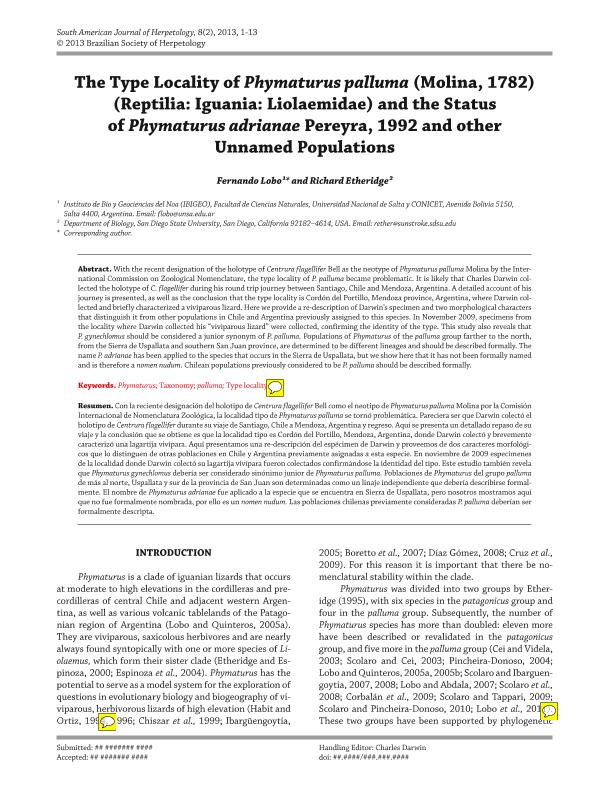Artículo
With the recent designation of the holotype of Centrura flagellifer Bell as the neotype of Phymaturus palluma Molina by the International Commission on Zoological Nomenclature, the type locality of P. palluma became problematic. It is likely that Charles Darwin collected the holotype of C. flagellifer during his round trip journey between Santiago, Chile and Mendoza, Argentina. A detailed account of his journey is presented, as well as the conclusion that the type locality is Cordón del Portillo, Mendoza province, Argentina, where Darwin collected
and briefly characterized a viviparous lizard. Here we provide a re-description of Darwin's specimen and two morphological characters that distinguish it from other populations in Chile and Argentina previously assigned to this species. In November 2009, specimens from the locality where Darwin collected his "viviparous lizard" were collected, confirming the identity of the type. This study also reveals that P. gynechlomus should be considered a junior synonym of P. palluma. Populations of Phymaturus of the palluma group farther to the north, from the Sierra de Uspallata and southern San Juan province, are determined to be different lineages and should be described formally. The name P. adrianae has been applied to the species that occurs in the Sierra de Uspallata, but we show here that it has not been formally named and is therefore a nomen nudum. Chilean populations previously considered to be P. palluma should be described formally. Con la reciente designación del holotipo de Centrura flagellifer Bell como el neotipo de Phymaturus palluma Molina por la Comisión Internacional de Nomenclatura Zoológica, la localidad tipo de Phymaturus palluma se tornó problemática. Pareciera ser que Darwin colectó el holotipo de Centrura flagellifer durante su viaje de Santiago, Chile a Mendoza, Argentina y regreso. Aquí se presenta un detallado repaso de su viaje y la conclusión que se obtiene es que la localidad tipo es Cordón del Portillo, Mendoza, Argentina, donde Darwin colectó y brevemente caracterizó una lagartija vivipara. Aquí presentamos una re-descripción del espécimen de Darwin y proveemos de dos caracteres morfológicos que lo distinguen de otras poblaciones en Chile y Argentina previamente asignadas a esta especie. En noviembre de 2009 especímenes de la localidad donde Darwin colectó su lagartija vivípara fueron colectados confirmándose la identidad del tipo. Este estudio también revela que Phymaturus gynechlomus debería ser considerado sinónimo junior de Phymaturus palluma. Poblaciones de Phymaturus del grupo palluma de más al norte, Uspallata y sur de la provincia de San Juan son determinadas como un linaje independiente que debería describirse formalmente. El nombre de Phymaturus adrianae fue aplicado a la especie que se encuentra en Sierra de Uspallata, pero nosotros mostramos aquí que no fue formalmente nombrada, por ello es un nomen nudum. Las poblaciones chilenas previamente consideradas P. palluma deberían ser formalmente descripta.
The Type Locality of Phymaturus palluma (Molina, 1782) (Reptilia: Iguania: Liolaemidae) and the Status of Phymaturus adrianae Pereyra, 1992 and Other Unnamed Populations
Fecha de publicación:
05/2013
Editorial:
Brazilian Society of Herpetology
Revista:
South American Journal of Herpetology
ISSN:
1808-9798
e-ISSN:
1937-2418
Idioma:
Inglés
Tipo de recurso:
Artículo publicado
Clasificación temática:
Resumen
Palabras clave:
Taxonomy
,
Herpetology
,
Phymaturus
,
Darwin
,
Species Identity
,
Andes
Archivos asociados
Licencia
Identificadores
Colecciones
Articulos(IBIGEO)
Articulos de INST.DE BIO Y GEOCIENCIAS DEL NOA
Articulos de INST.DE BIO Y GEOCIENCIAS DEL NOA
Citación
Lobo Gaviola, Fernando Jose; Etheridge, Richard; The Type Locality of Phymaturus palluma (Molina, 1782) (Reptilia: Iguania: Liolaemidae) and the Status of Phymaturus adrianae Pereyra, 1992 and Other Unnamed Populations; Brazilian Society of Herpetology; South American Journal of Herpetology; 8; 2; 5-2013; 89-101
Compartir
Altmétricas




